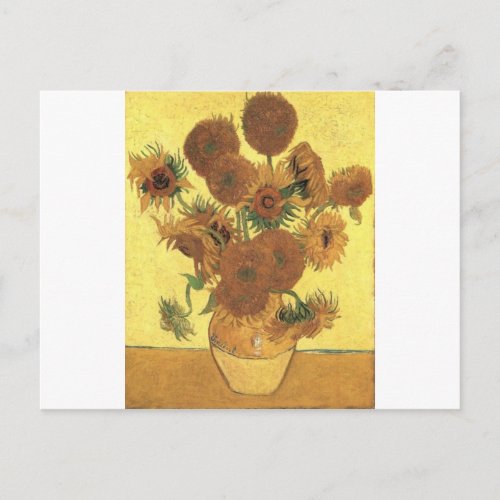Sunflowers by Van Gogh Postcard



Still Life: Vase with Fifteen Sunflowers Painting by Vincent van Gogh For expressionism is not simply a way of seeing things: it is also a way of making them, of painting them. An expressionist does not paint "flat" and in pure tones--he breaks up his tones and applies them with a liberal brush. It is striking indeed to find in Rembrandt, Hals, and the Van Gogh of the Nuenen period, the same concern for realism, the same sense of light and feeling for expressive detail, combined with a use of impasto that is no less expressive. In short, even the most detached and idealistic Dutch painters bear the mark of their national cultural traditions. Vermeer, however abstract, came under the infleunce of Caravaggio, that is to say, of realism; and, in our own time, Mondrian's abstractions represent an unusual aesthetic puritanism with a social bias. And Rembrandt's light is the spiritual expression of an observed reality--or at least of such elements of that reality as may be observed. But such realism, however frank (as in Frans Hals), is not so much concerned to respect the real, the physical aspect of things, as to express it. And while Van Gogh, as a Dutch painter, was certainly deeply attached to reality, his almost religious deference for it was not divorced from painterly considerations. Hence that arbitrary lighting, that no less arbitrary, dramatic and often caricatural distortion--in short, that rugged, uncouth expressionism in which there is nevertheless a glimmer of the total lyrical expression that would later be his. So it is that this essentially lyric painter began by painting the plebeian reality of his time, just as--he must have imagined--Rembrandt and Hals painted the bourgeois reality of theirs. The Head of an Old Peasant Woman, painted at Nuenen, and the hands of the Potato-Eaters thus echo in their crude, awkward way the Portrait of Margaretha Trip and the hands of the Regentessen. But Van Gogh had, as it were, mistaken the shadow for the substance, failing to perceive that Rembrandt's realism was in essence illusory. If the Dutch petits maîtres, and even more a major figure like the virtuoso Hals, were realists--reproducing, interpreting or stylizing reality--Rembrandt, over and above his subject-matter, was a man obsessed by a light that was not of this world and which he pursued untiringly through the labyrinths of chiaroscuro. And Van Gogh, fancying himself a social realist, did not as yet realize that it was his mission, and his alone, not simply to mold the recalcitrant clay of reality but to liberate the pent-up inner light of the Night Watch and reveal it in all its radiance. Until that moment came, however, he was to languish in the sullen blacks and browns that express the "human, all too human" side of things. It was this innate taste for reality, moreover--above all, the reality of workers' and peasants' lives--which led him to admire and study the "painters after his own heart," for he had yet to enter on the period of color innovation that was to link him up with other masters. Intuitive by nature and selftaught by inclination and the force of circumstances, Van Gogh always felt impelled to turn to the great painters, regarding them not so much as models in matters of technique as symbolic sponsors of his own experiments. His worship of Millet went deeper than a mere appreciation of his social realism, his predilection for human themes. He was no doubt first attracted by the way in which Millet depicted humble tillers of the soil and so well brought out those essential volumes that were in keeping with this subject. But a study of Van Gogh's various interpretations of Millet's pictures --The Reaper, The Midday Rest, The Sower--reveals that, for him, the all too famous stance of the sower, both realistic and romantic, was no mere literary or melodramatic gesture. For Van Gogh it expressed his own innermost being, his deep yearning for the soil, which he saw as the symbol, at once life-giving and oppressive, of reality as he had experienced it. Later, at Saint-Rémy, when he was repainting his early memories in those vivid colors which he had already borne within him in Holland without being aware of it, he recreated Millet's work in his own image. Delacroix was, to his mind, the embodiment of expression in terms of color. Van Gogh had already discovered that master in Holland, and at Arles did not forget him. It is worth noting that, in a letter to Theo ( September 8, 1888), he quoted Paul Mantz's comment on the sketch for Christ on the Lake of Gennesareth: "I never realized one could get such terrific effects out of blue and green."


